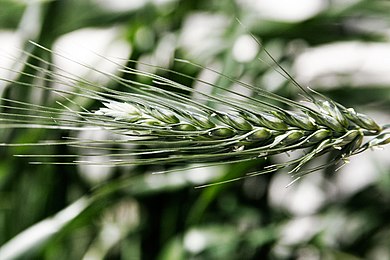| This article needs additional citations for verification. Please help improve this article by adding citations to reliable sources. Unsourced material may be challenged and removed. Find sources: "Awn" botany – news · newspapers · books · scholar · JSTOR (December 2009) (Learn how and when to remove this message) |


In botany, an awn is either a hair- or bristle-like appendage on a larger structure, or in the case of the Asteraceae, a stiff needle-like element of the pappus.
Awns are characteristic of various plant families, including Geraniaceae and many grasses (Poaceae).
Among grasses with awns are those commonly known as foxtails, which tend to stick to animals passing by the plant.
Description
In grasses, awns typically extend from the lemmas of the florets. This often makes the hairy appearance of the grass synflorescence. Awns may be long (several centimeters) or short, straight or curved, single or multiple per floret. Some biological genera are named after their awns, such as the three-awns (Aristida).
In some species, the awns can contribute significantly to photosynthesis, as, for example, in barley.
The awns of wild emmer-wheat spikelets effectively self-cultivate by propelling themselves mechanically into soils. During a period of increased humidity during the night, the awns of the spikelet become erect and draw together, and in the process push the grain into the soil. During the daytime the humidity drops and the awns slacken back again; however, fine silica hairs on the awns act as ratchet hooks in the soil and prevent the spikelets from reversing back out again. During the course of alternating stages of daytime and nighttime humidity, the awns' pumping movements, which resemble swimming frog kick, drill the spikelet as much as an inch into the soil.


When awns occur in the Geraniaceae, they form the distal (rostral) points of the five carpels, lying parallel in the style above the ovary. Depending on the species, such awns have various seed-dispersal functions, either dispersing the seed by flinging it out (seed ejection); flinging away the entire carpel so that it snaps off (carpel projection); entangling the awn or bristles on passing animals (zoochory); or possibly burying the seed by twisting as it lies on soft soil.
References
- Elbaum, Rivka; Zaltzman, Liron; Burgert, Ingo; Fratzl, Peter (2007). "The Role of Wheat Awns in the Seed Dispersal Unit". Science. 316 (5826): 884–886. Bibcode:2007Sci...316..884E. doi:10.1126/science.1140097. PMID 17495170.
- Yeo, P. F. (1984). "Fruit-discharge-type in Geranium (Geraniaceae): its use in classification and its evolutionary implications". Botanical Journal of the Linnean Society 89: 1–36. doi: 10.1111/j.1095-8339.1984.tb00998.x
- "PlantZAfrica.com Homepage". www.plantzafrica.com.
External links
This plant morphology article is a stub. You can help Misplaced Pages by expanding it. |